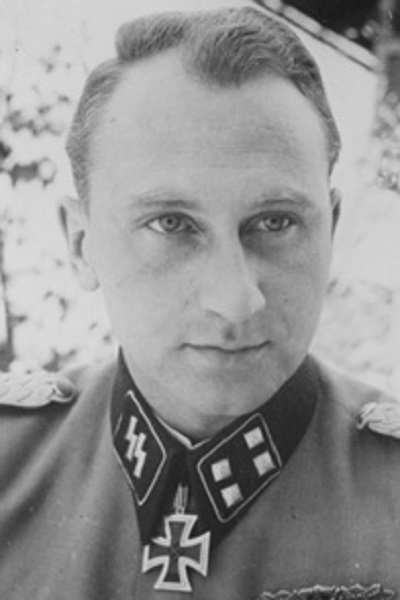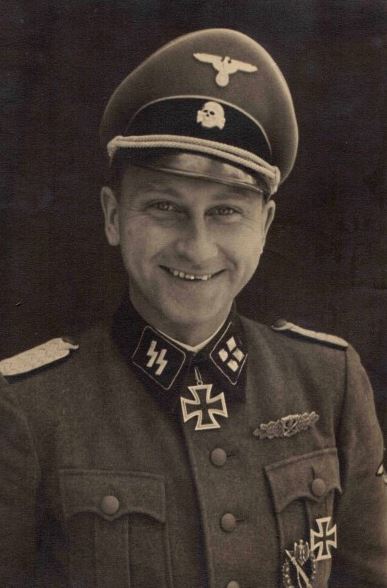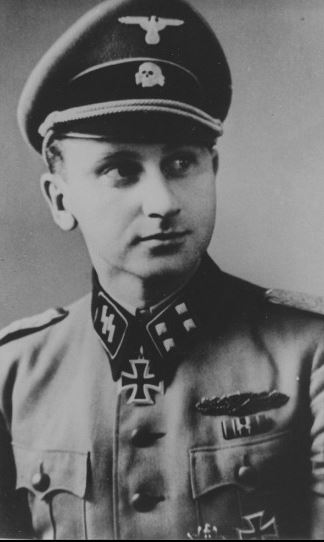Schäfer, Ernst (Waffen SS)
- Date of birth:
- December 16th, 1913 (Neuruppin, Germany)
- Date of death:
- March 15th, 1975 (Salzburg, Austria)
- Service number:
- SS-Nr.: 265.705 // NSDAP-Nr.: 3.602.128
- Nationality:
- German
Biography
Promotions:
30.07.1934: SS-Anwärter
00.00.1934: SS-Mann
00.00.1936: SS-Standartenjunker
00.00.1937: SS-Standartenoberjunker
20.04.1937: SS-Untersturmführer
20.09.1938: Leutnant
09.11.1938: SS-Obersturmführer
01.08.1939: SS-Hauptsturmführer
21.06.1943: SS-Sturmbannführer - RDA 21.06.1942
07.10.1944: SS-Obersturmbannführer
00.00.1945: SS-Standartenführer (unconfirmed)
Career:
20.04.1933-30.07.1934: FAD / Freiwillige Arbeitsdienst
30.07.1934: joined the NSDAP and the SS
Do you have more information about this person? Inform us!
- Awarded on:
- 1937
- Period:
- Second World War (1939-1945)
- Awarded on:
- August 15th, 1941
- Period:
- Second World War (1939-1945)
- Awarded on:
- February 27th, 1942
- Period:
- Second World War (1939-1945)
- Awarded on:
- March 10th, 1942
- Period:
- Second World War (1939-1945)
- Awarded on:
- August 1st, 1942
- Period:
- Second World War (1939-1945)
- Awarded on:
- January 30th, 1943
- Period:
- Second World War (1939-1945)
- Awarded on:
- May 1st, 1943
- Period:
- Second World War (1939-1945)
- Rank:
- SS-Sturmbannführer (Major)
- Unit:
- Kommandeur, III. Bataillon, SS-Grenadier-Regiment (mot) 10, 1. SS-Infanterie-Brigade (mot)
- Awarded on:
- October 14th, 1943
"During the heavy fighting east of the railway line Smolensk-Rosslawl on the 22.-24.09.1943, the SS-Gren.Rgt. 10 (mot) was deployed under the command of the 35. Jäger-Division. The III./SS-Gren.Rgt. 10 (mot) was detached from the Regiment and employed directly in front of Kraspoff on the left flank of the Division. After very difficult fighting in this area, the 35. Jäger-Division became divided and had to retreat. The Soviets moved around immediately on the right flank. With this, the Battalion Commander, SS-Sturmbannführer Schaefer, came forward to orientate himself as to the situation. At around 10:00 hours he observed that the enemy had advanced deeply into the right flank. After he was unable to receive any orders from higher levels, he took the independent decision to the leave one-and-a-half Schützen Kompanies on the left flank as protection and then moved the remainder to the right in the direction of Mogdanez. He ordered them back to 2 important heights. After this he, along with the Leader of the 12. Kompanie, his Adjutant, the Combat Clerk, three Messengers and a Driver got into combat positions on a different hill. They defended this and fought off around 200 enemy infantry and sixty cavalry, supported by artillery, mortars and aerial attacks. Standing upright, he fired with his machine-pistol into the attacking Soviets or forced them to go to ground with hand grenades. Two tanks attacked his handful of men, but the defenders held their nerve and let them roll over them. With his few men, they continued to defend against the infantry and cavalry and fired into the Soviets, shouting "hurrah" with their two light machine guns. In the meantime the two tanks were destroyed by artillery fire.
Two things then took place immediately. Schaefer, through personal circumspection, removed himself from the enemy and also produced a link between his Kompanie and the Battalion, thereby strengthening the position of the entire Battalion. In the meantime he had also made a connection between other units of the SS-Gren.Rgt. 10 (mot.), which certainly secured the positions of the I./SS-Gren.Rgt. 10 (mot.). Schaefer, the soul of his Battalion, had engaged the Bolshevik infantry and cavalry with well-aimed machine gun fire and hand grenades, inflicting heavy losses on them and forcing them to adjust their attack (which no longer continued into the evening).
Schaefer, an active participant in the battle during this enemy attack, led his Battalion and kept the defence intact. In doing so he facilitated the planning of a new frontline at the railway by the Regiment through his cool-headed and determined defence. He himself would later hold this line until the 1. SS-Infantry Brigade (mot.) arrived. The major tactical results of his actions were...
1.) Enabling the 35. Jäger-Division to retain its position.
2.) Making it possible for the XXXIX. Armee-Korps to prepare its positions on the south flank over the Dnieper bridge.
Schaefer calmly held the decisive front between the IX. and XXXIX. Armee-Korps."
Vorschlag dated 30.09.1943 and signed by the Brigade Fhr. Wilhelm Trabandt
- Period:
- Second World War (1939-1945)
- Awarded on:
- October 16th, 1943
- Period:
- Second World War (1939-1945)
- Rank:
- SS-Sturmbannführer (Major)
- Unit:
- Kdr, SS-Panzer-Grenadier-Regiment 40, 18. SS-Freiwilligen-Panzergrenadier-Division "Horst Wessel"
- Awarded on:
- November 8th, 1944
Sources
- Photo 1: Igor Poul
- Photo 2:
- Photo 3:
- - MOONEY, PETER, Waffen-SS Knights and their Battles, Schiffer Publishing, Ltd., 2012.
- Die Ordensträger der Deutschen Wehrmacht



















